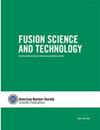MT-II型托卡马克壁面调节技术优化
IF 1.2
4区 工程技术
Q3 NUCLEAR SCIENCE & TECHNOLOGY
引用次数: 0
摘要
摘要MT-II是目前正在巴基斯坦托卡马克等离子体研究所建造的小型球形托卡马克。MT-II型真空容器(VV)的壁面调节是实现等离子体实验高质量真空的必要步骤。本研究概述了MT-II VV上实施的壁面调节技术,包括烘烤和辉光放电清洗(GDC)。在进行壁面调节之前,通过氦气泄漏测试机和残余气体分析仪(RGA)对系统进行检查,以识别和消除泄漏。VV壁在~180℃下烘烤,以快速解吸水蒸气和其他杂质。经过烘烤过程后,大多数含碳和含氧杂质的分压降低。特别是水蒸气的分压降低了93%。因此,总泄漏和放气速率显著降低。为了进一步改善容器内的真空条件,进行了氢气GDC。为了获得稳定的辉光放电,对充氢压力和阳极电压进行了优化。RGA扫描显示,GDC使H2O、O2和CO2的分压分别降低了57%、63%和51%。结果表明,烘培和GDC是MT-II型VV壁面调理的有效技术。关键词:MT-II托卡马克烘烤辉光放电清洗泄漏率残余气体分析仪披露声明作者未报告潜在利益冲突。本项目部分由巴基斯坦计划委员会、巴基斯坦政府和国际原子能机构协调研究项目(CRP-F13018)在研究基金PAK-22840的资助下提供资助。本文章由计算机程序翻译,如有差异,请以英文原文为准。
Optimization of Wall-Conditioning Techniques on the MT-II Tokamak
AbstractThe MT-II is a small spherical tokamak that is currently under construction at the Pakistan Tokamak Plasma Research Institute. Wall conditioning of the MT-II vacuum vessel (VV) is an essential step to achieve a good quality vacuum for plasma experiments. This study presents an overview of the wall-conditioning techniques implemented on the MT-II VV, including baking and glow discharge cleaning (GDC). Prior to wall conditioning, the system is checked via a helium leak test machine and residual gas analyzer (RGA) to identify and remove leaks. The VV walls are baked at ~180 °C to get rapid desorption of water vapors and other impurities. After the baking process, the partial pressure of most of the carbon- and oxygen-containing impurities is reduced. In particular, the partial pressure of water vapors is reduced by 93%. Consequently, the total leak and outgassing rate is significantly reduced. To further improve the vacuum condition in the vessel, hydrogen GDC is carried out. The fill hydrogen pressure and anode voltage are optimized to get a stable glow discharge. The RGA scan shows that GDC reduces the partial pressure of H2O, O2, and CO2 by 57%, 63%, and 51%, respectively. The results signify that baking and GDC are effective techniques for wall conditioning of the MT-II VV.Keywords: MT-II tokamakbakingglow discharge cleaningleak rateresidual gas analyzer Disclosure StatementNo potential conflict of interest was reported by the authors.Additional informationFundingThis project was partially supported by a grant-in-aid from the Planning Commission, Government of Pakistan, and the International Atomic Energy Agency coordinated research project (CRP-F13018) under research grant PAK-22840.
求助全文
通过发布文献求助,成功后即可免费获取论文全文。
去求助
来源期刊

Fusion Science and Technology
工程技术-核科学技术
CiteScore
2.00
自引率
11.10%
发文量
60
审稿时长
3 months
期刊介绍:
Fusion Science and Technology, a research journal of the American Nuclear Society, publishes original research and review papers on fusion plasma physics and plasma engineering, fusion nuclear technology and materials science, fusion plasma enabling science technology, fusion applications, and fusion design and systems studies.
 求助内容:
求助内容: 应助结果提醒方式:
应助结果提醒方式:


